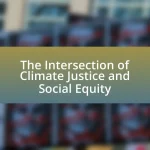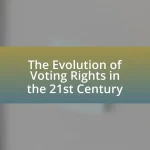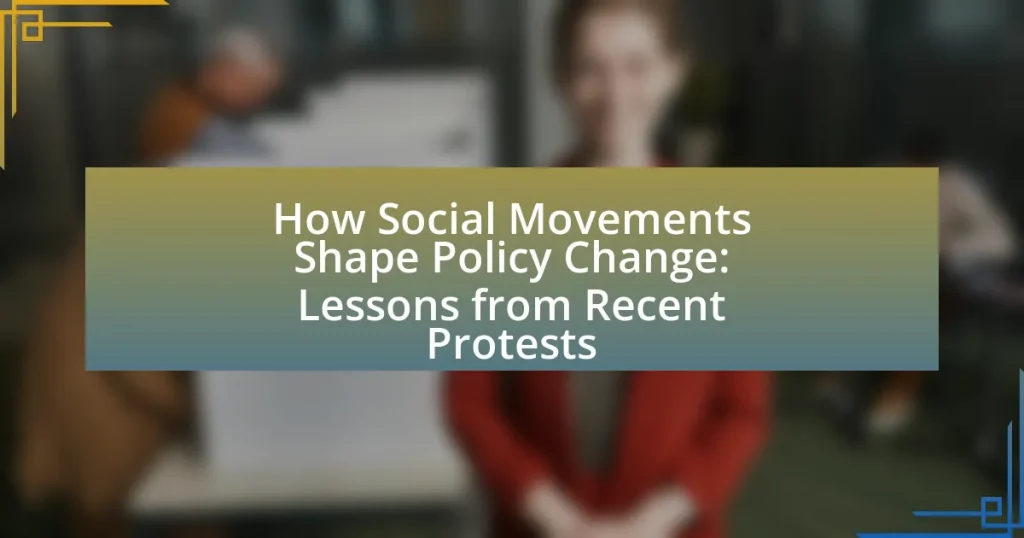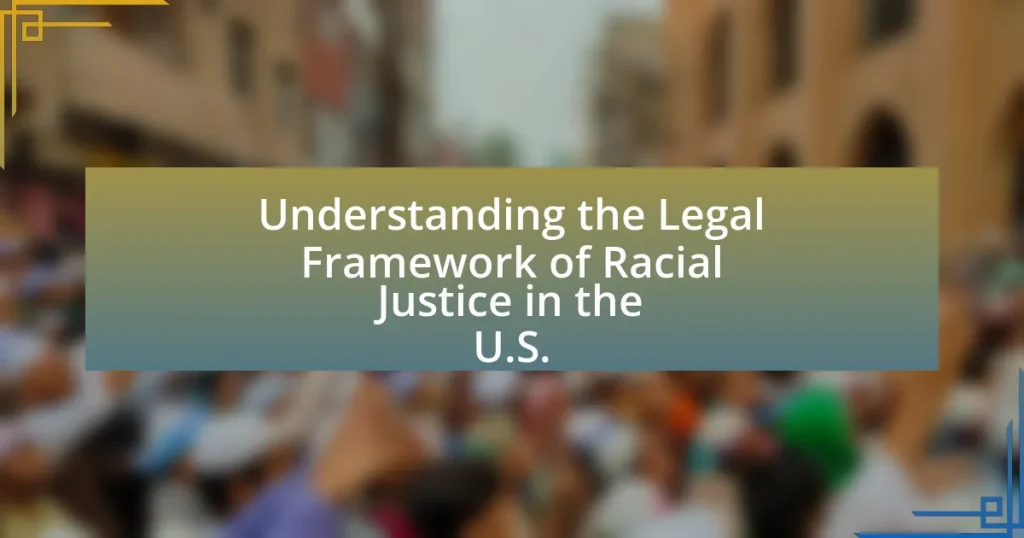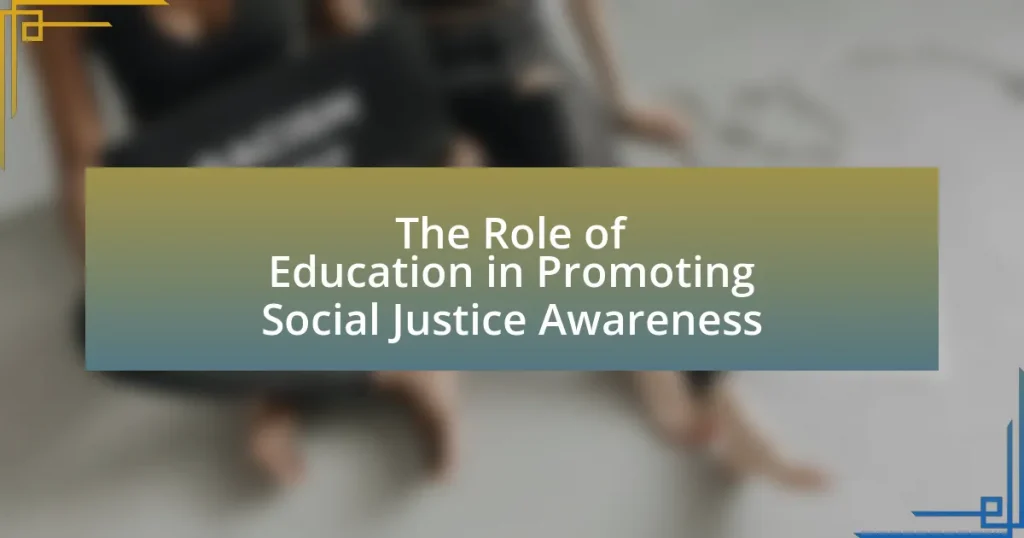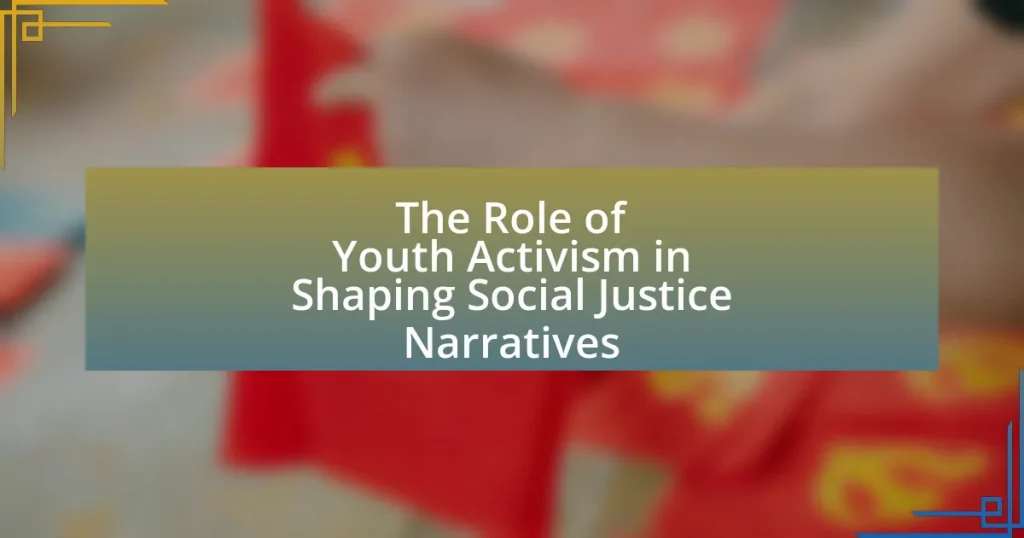The article examines how social movements influence policy change, highlighting their role in mobilizing public opinion, advocating for specific issues, and applying pressure on policymakers. It discusses key mechanisms such as collective action, framing, and grassroots mobilization, illustrating their effectiveness through historical and recent examples like the Civil Rights Movement and Black Lives Matter. The article also explores the significance of public awareness, coalition-building, and strategic communication in driving legislative reforms, while addressing challenges faced by movements and the impact of governmental responses. Key takeaways emphasize the importance of clear messaging, community engagement, and data-driven advocacy for future social movements.
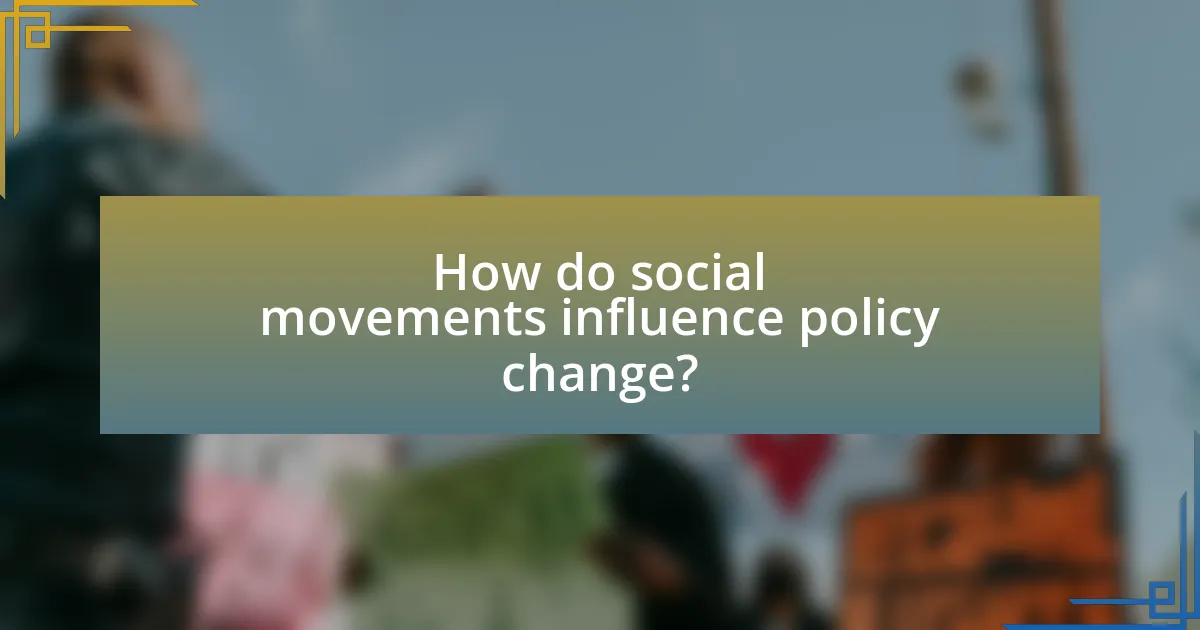
How do social movements influence policy change?
Social movements influence policy change by mobilizing public opinion, advocating for specific issues, and applying pressure on policymakers. For instance, the Civil Rights Movement in the 1960s successfully led to the passage of the Civil Rights Act of 1964 and the Voting Rights Act of 1965 by raising awareness about racial injustices and organizing mass protests. These movements often utilize strategies such as grassroots organizing, media campaigns, and coalition-building to amplify their messages and create a sense of urgency around their demands, which can compel legislators to respond. Research indicates that social movements can significantly alter the political landscape, as seen in the recent climate strikes led by youth activists, which have prompted governments worldwide to adopt more aggressive climate policies.
What are the key mechanisms through which social movements operate?
Social movements operate through key mechanisms such as collective action, framing, and mobilization. Collective action involves individuals coming together to pursue a common goal, often leading to protests or demonstrations that raise awareness and pressure decision-makers. Framing refers to the way movements construct narratives that resonate with the public and influence perceptions, thereby garnering support. Mobilization encompasses the strategies used to engage participants, including grassroots organizing and leveraging social media to spread messages rapidly. These mechanisms have been evidenced in various movements, such as the Civil Rights Movement, which utilized collective action and framing to achieve significant policy changes in the United States.
How do grassroots organizing and mobilization contribute to policy shifts?
Grassroots organizing and mobilization significantly contribute to policy shifts by creating a collective voice that influences decision-makers. This process often involves community engagement, where individuals come together to advocate for specific issues, thereby raising awareness and generating public support. For instance, the Black Lives Matter movement effectively mobilized grassroots efforts to address systemic racism, leading to policy discussions around police reform in various cities. Research indicates that grassroots movements can sway public opinion, which in turn pressures policymakers to respond to constituents’ demands, as seen in the 2018 March for Our Lives campaign advocating for gun control. Such mobilization not only amplifies marginalized voices but also fosters a sense of urgency that can lead to legislative changes.
What role does public awareness play in shaping policy outcomes?
Public awareness significantly influences policy outcomes by mobilizing public opinion and pressuring decision-makers. When citizens are informed about specific issues, such as climate change or social justice, they are more likely to advocate for change, leading to increased political engagement and activism. For instance, the widespread awareness generated by the Black Lives Matter movement has resulted in legislative changes regarding police reform in various jurisdictions. Studies show that heightened public awareness can lead to a 20% increase in the likelihood of policy adoption related to social issues, demonstrating the direct correlation between informed citizens and effective policy change.
Why are recent protests significant in the context of policy change?
Recent protests are significant in the context of policy change because they mobilize public opinion and pressure decision-makers to address specific grievances. For instance, the Black Lives Matter protests in 2020 led to widespread discussions on police reform, resulting in legislative proposals in various states aimed at increasing accountability and transparency in law enforcement. This demonstrates how collective action can influence political agendas and prompt governmental responses to societal demands.
What specific events have catalyzed policy discussions in recent years?
Recent protests, particularly the Black Lives Matter movement following the death of George Floyd in 2020, have catalyzed significant policy discussions regarding police reform and racial justice in the United States. This event sparked nationwide demonstrations and led to calls for changes in law enforcement practices, resulting in various legislative proposals at local, state, and federal levels aimed at addressing systemic racism and police accountability. Additionally, the COVID-19 pandemic has prompted discussions around public health policy, economic inequality, and social safety nets, highlighting the need for comprehensive reforms in healthcare and economic support systems. These events have mobilized public opinion and influenced policymakers to reconsider existing frameworks and implement changes that reflect the demands of social movements.
How do social movements leverage media to amplify their messages?
Social movements leverage media to amplify their messages by utilizing various platforms to reach broader audiences and create impactful narratives. They employ social media, traditional news outlets, and digital content to disseminate information rapidly, engage supporters, and mobilize action. For instance, the Black Lives Matter movement effectively used Twitter and Instagram to share real-time updates and personal stories, which contributed to widespread awareness and participation in protests. Research indicates that social media campaigns can increase public engagement significantly; a study by the Pew Research Center found that 69% of adults in the U.S. use social media, making it a powerful tool for movements to influence public opinion and policy discussions.
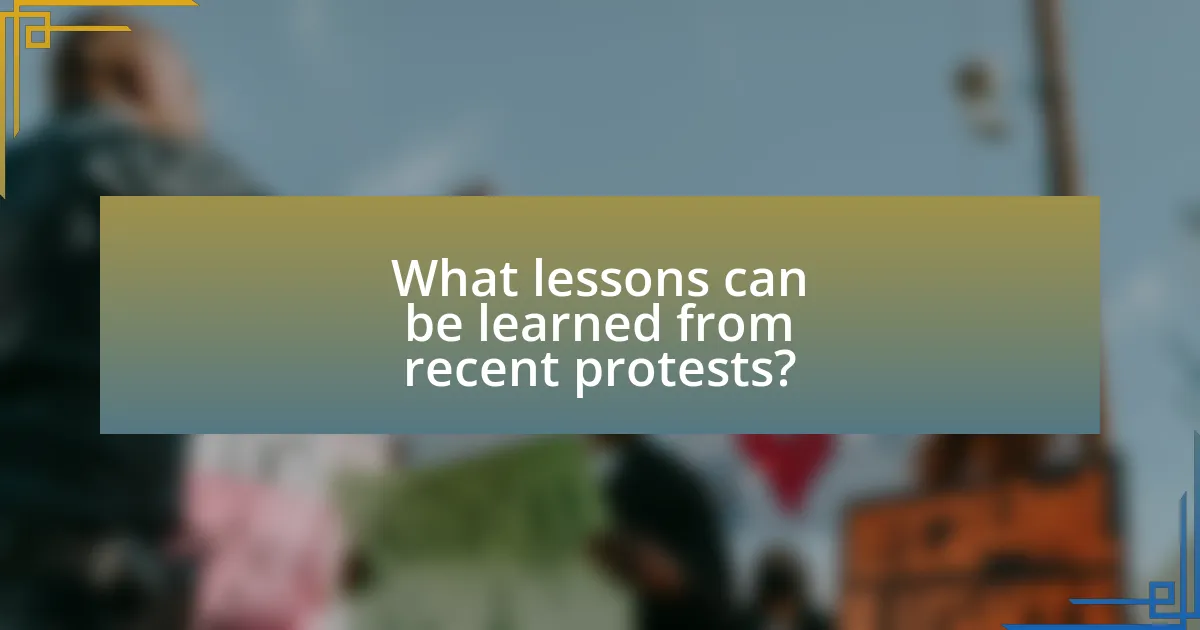
What lessons can be learned from recent protests?
Recent protests demonstrate the power of collective action in influencing policy change. These movements often highlight societal issues that require urgent attention, as seen in the Black Lives Matter protests, which brought systemic racism and police reform to the forefront of national discourse. Additionally, protests can mobilize diverse groups, creating a broader coalition for change, evidenced by the global climate strikes that united individuals across various demographics to advocate for environmental policies. Furthermore, the effectiveness of protests is often amplified by strategic use of social media, which facilitates rapid information dissemination and organization, as observed during the Arab Spring. These lessons underscore the importance of unity, strategic communication, and the ability to spotlight critical issues in driving meaningful policy reforms.
How have different movements achieved varying levels of success?
Different movements have achieved varying levels of success based on their strategies, public support, and the political context in which they operate. For instance, the Civil Rights Movement in the United States successfully led to significant legislative changes, such as the Civil Rights Act of 1964, due to its organized grassroots efforts, widespread media coverage, and strong leadership. In contrast, the Occupy Wall Street movement faced challenges in translating its message into concrete policy changes, partly due to a lack of clear objectives and cohesive leadership. Research indicates that movements with specific goals and the ability to mobilize large numbers of supporters tend to be more effective; for example, the Women’s March in 2017 galvanized millions and influenced political discourse, demonstrating the power of collective action in shaping policy.
What strategies have proven effective in influencing policymakers?
Effective strategies for influencing policymakers include grassroots mobilization, strategic framing of issues, and coalition-building among diverse stakeholders. Grassroots mobilization engages citizens directly, creating a strong base of support that can pressure policymakers to act. For example, the Women’s March in 2017 galvanized millions, demonstrating the power of collective action in shaping public discourse and policy priorities. Strategic framing involves presenting issues in a way that resonates with policymakers’ values and priorities, making them more likely to support proposed changes. The framing of climate change as a public health issue has successfully garnered attention from policymakers who prioritize health outcomes. Coalition-building brings together various organizations and interest groups, amplifying voices and resources, as seen in the Fight for $15 movement, which united labor unions, community organizations, and advocacy groups to push for higher minimum wages. These strategies have been validated through numerous case studies and analyses of social movements’ impacts on policy change.
How do coalition-building efforts enhance the impact of social movements?
Coalition-building efforts enhance the impact of social movements by uniting diverse groups to amplify their collective voice and resources. This collaboration allows for a broader range of perspectives and expertise, which can lead to more effective strategies and increased visibility. For instance, the 2017 Women’s March in the United States brought together various organizations advocating for women’s rights, racial justice, and LGBTQ+ rights, resulting in a significant turnout and media attention that influenced public discourse and policy discussions. By pooling resources and sharing networks, coalitions can mobilize larger numbers of participants, secure funding, and create a unified front that is more difficult for policymakers to ignore.
What challenges do social movements face in effecting change?
Social movements face significant challenges in effecting change, including political resistance, fragmentation within the movement, and resource limitations. Political resistance often manifests through government pushback, legal obstacles, or repression, as seen in various protests where authorities have employed force to suppress dissent. Fragmentation occurs when differing ideologies or goals within the movement lead to disunity, which can weaken collective action and dilute messaging. Resource limitations, such as funding and organizational capacity, hinder the ability to mobilize effectively and sustain long-term campaigns, as evidenced by studies showing that well-funded movements tend to achieve more substantial outcomes.
How do governmental responses shape the trajectory of social movements?
Governmental responses significantly shape the trajectory of social movements by either facilitating or suppressing their progress. For instance, when governments engage in dialogue and implement reforms in response to protests, movements often gain momentum and legitimacy, as seen in the 2011 Arab Spring, where some governments made concessions to appease demonstrators. Conversely, repressive actions, such as arrests and violence against protesters, can lead to increased solidarity among movement participants and heightened public awareness, as evidenced by the Black Lives Matter movement, which gained international attention following governmental crackdowns. Thus, the nature of governmental responses directly influences the effectiveness, visibility, and evolution of social movements.
What are the risks of backlash against social movements?
Backlash against social movements can lead to increased repression, polarization, and the undermining of the movement’s goals. Repression may manifest through legal actions, violence, or censorship aimed at activists, as seen in various countries where governments have cracked down on protests. Polarization occurs when societal divisions deepen, making it harder for opposing groups to find common ground, which can hinder constructive dialogue and compromise. Additionally, backlash can result in the delegitimization of the movement’s objectives, as opponents may frame the movement as extreme or disruptive, thereby swaying public opinion against it. Historical examples include the backlash against the civil rights movement in the United States, where increased hostility and violence were directed at activists, ultimately complicating their efforts for change.
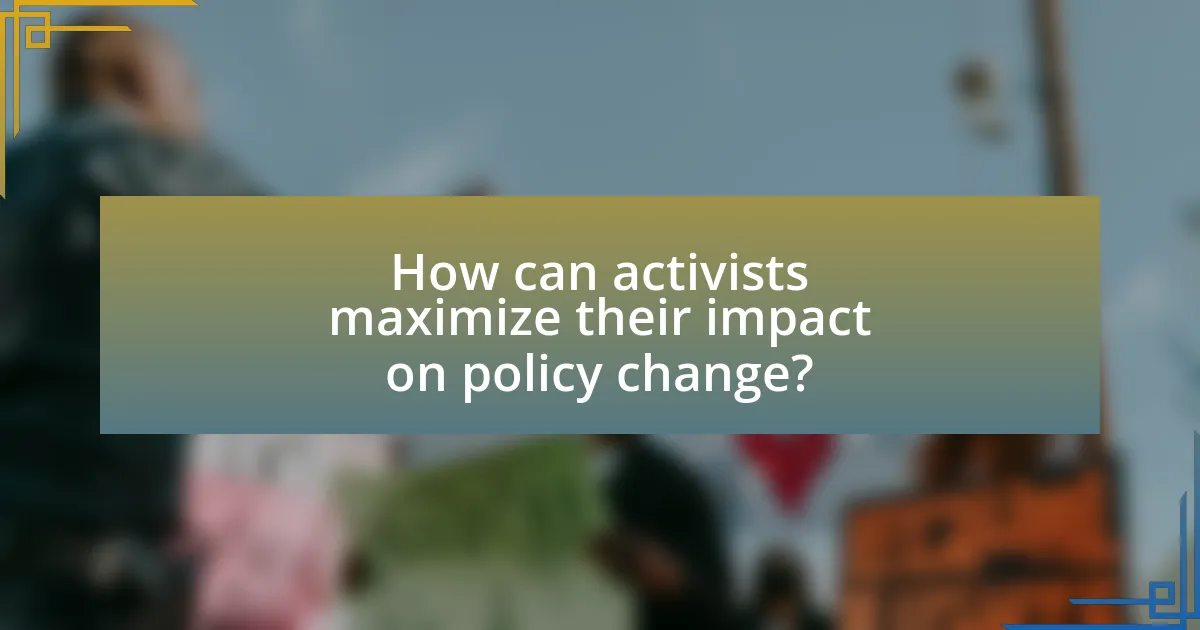
How can activists maximize their impact on policy change?
Activists can maximize their impact on policy change by strategically organizing grassroots campaigns that mobilize public support and influence decision-makers. Effective strategies include building coalitions with diverse stakeholders, utilizing social media for outreach, and employing data-driven advocacy to present compelling arguments. For instance, the 2018 March for Our Lives movement successfully galvanized youth and community support for gun control legislation, leading to significant policy discussions in various states. This demonstrates that well-coordinated efforts can create substantial pressure on policymakers, resulting in tangible legislative outcomes.
What best practices should social movements adopt for effective advocacy?
Social movements should adopt clear messaging, strategic coalition-building, and data-driven advocacy for effective advocacy. Clear messaging ensures that the movement’s goals are easily understood by the public and policymakers, as seen in the Black Lives Matter movement, which effectively communicated its demands for racial justice. Strategic coalition-building allows movements to unite diverse groups, amplifying their voices and resources; for instance, the Women’s March brought together various organizations advocating for gender equality. Data-driven advocacy involves using research and statistics to support claims, which can enhance credibility and influence policy decisions, as demonstrated by climate movements that utilize scientific data to advocate for environmental policies.
How can data and research support the goals of social movements?
Data and research can support the goals of social movements by providing evidence-based insights that validate their claims and strategies. For instance, statistical analyses can reveal disparities in social issues, such as income inequality or racial discrimination, which movements can leverage to advocate for policy changes. Research studies, like those conducted by the Pew Research Center, have shown that public support for social movements often increases when backed by credible data, as seen in the rise of support for the Black Lives Matter movement following the release of data on police violence. Furthermore, data can help social movements identify key demographics and tailor their messaging effectively, enhancing outreach and engagement.
What role does community engagement play in sustaining momentum?
Community engagement is crucial for sustaining momentum in social movements as it fosters a sense of ownership and collective responsibility among participants. When individuals actively participate in community initiatives, they are more likely to remain committed and motivated, which is essential for the longevity of any movement. Research indicates that movements with strong community ties, such as the Black Lives Matter movement, have demonstrated increased resilience and adaptability, allowing them to maintain pressure on policymakers over time. This engagement not only amplifies voices but also mobilizes resources and networks, creating a robust support system that can effectively advocate for policy change.
What are the key takeaways for future social movements?
Key takeaways for future social movements include the importance of strategic coalition-building, effective use of digital platforms, and the necessity of clear messaging. Strategic coalition-building enhances the movement’s reach and impact, as seen in the Black Lives Matter movement, which successfully united various organizations and demographics to advocate for racial justice. Effective use of digital platforms allows for rapid mobilization and information dissemination, exemplified by the Arab Spring, where social media played a crucial role in organizing protests. Clear messaging ensures that the movement’s goals are understood and supported by the public, as demonstrated by the Women’s March, which articulated specific demands for gender equality. These elements are essential for driving policy change and sustaining momentum in social movements.
How can lessons from recent protests inform future strategies?
Lessons from recent protests can inform future strategies by highlighting the importance of grassroots organization, effective communication, and adaptability. For instance, the Black Lives Matter movement demonstrated that decentralized leadership and local engagement can mobilize diverse communities and sustain momentum. Additionally, the use of social media platforms for real-time updates and coordination has proven essential in amplifying messages and reaching wider audiences, as seen during the 2020 protests. These strategies can be validated by the significant policy discussions and changes that followed, such as police reform initiatives in various cities, indicating that well-organized movements can lead to tangible outcomes.
What common pitfalls should activists avoid in their campaigns?
Activists should avoid the common pitfalls of lack of clear messaging, insufficient research, and failure to engage with the community. Clear messaging is crucial; campaigns with ambiguous goals often fail to resonate with the target audience, leading to confusion and disengagement. Insufficient research can result in misinformed strategies that do not address the actual needs or concerns of the community, undermining the campaign’s effectiveness. Additionally, failing to engage with the community can alienate potential supporters and diminish the campaign’s impact, as grassroots support is essential for mobilizing action and achieving policy change. These pitfalls have been observed in various movements, such as the Occupy Wall Street movement, which struggled with messaging clarity and community engagement, ultimately limiting its long-term influence.



